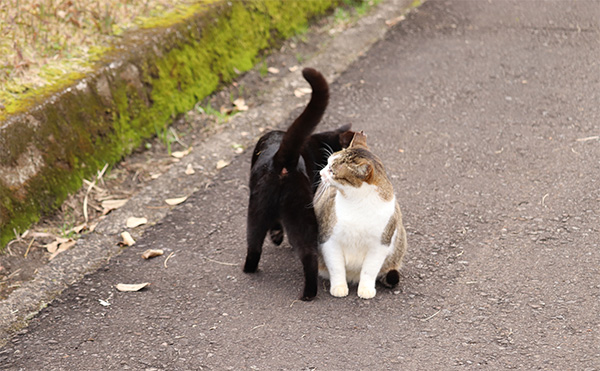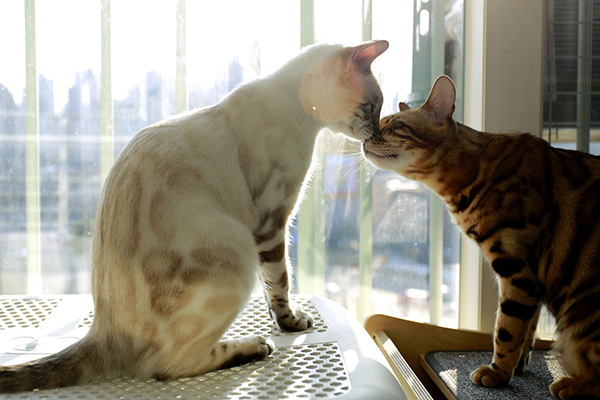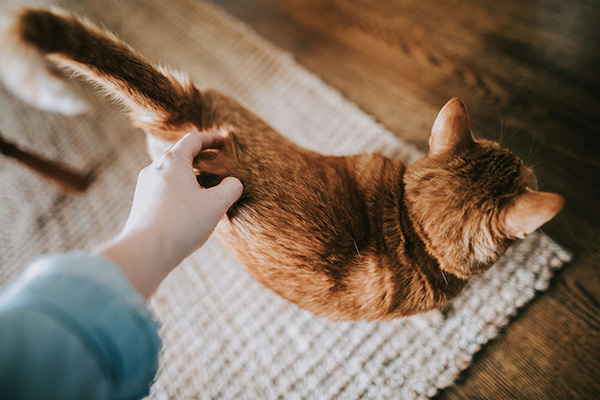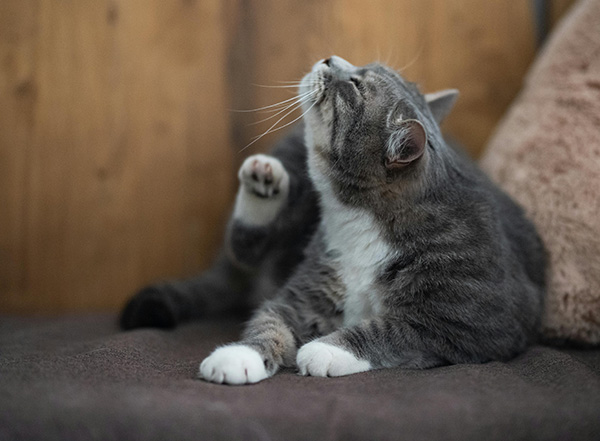If you've ever asked yourself, "Why does my cat put his butt in my face?" you're definitely not alone. Among the array of quirky cat behaviors, having your cat put its butt in your face might not seem like a gesture of love, but in the feline world, it actually might be. This behavior is deeply rooted in the way cats communicate with each other. Like dogs, cats greet each other in the wild by sniffing rear ends. When your cat does this to you, they extend a friendly gesture and demonstrate trust and familiarity.
In this article, we'll explore the main reasons behind this peculiar cat behavior, as explained by veterinarians.
Trust and Affection
Although it may seem peculiar, when your furry friend presents its rear end to you, it is actually a gesture of trust and affection. They do this to express that they feel safe and comfortable in your presence, pointing their rear towards you as a sign of trust because they believe you will keep them safe. It’s a gesture rooted in instinct, love, and trust, revealing their true selves and conveying a sense of belonging and familiarity.
Unlike humans, cats don’t see their rear end, often referred to as their “cat butt,” as vulgar; instead, they want to share this part of themselves with their special friends. This behavior also indicates a desire for affection, often accompanied by a raised tail and purring. In fact, cat butts can be seen as a sign of trust and closeness between feline friends, especially when a cat sleeps nearby.
Vulnerable Area
When a cat exposes its rear end, it shows a deeply vulnerable area, which signifies profound trust. This act is not merely about trust; it also displays their comfort and willingness to connect, confident that you won’t harm them. It strongly indicates that your cat feels comfortable and secure around you, which is a significant compliment.
Alternatively, this behavior might also be a request for a gentle rub. Cats often lift their hindquarters when they feel relaxed and want to engage with their owners. It’s a way for them to signal that they’re relaxed and open to interaction, often looking for a gentle scratch or petting in that spot.
Feline Friend Bonding

Cats displaying their rear ends is a form of social bonding that originates from their kittenhood. It is rooted in mutual grooming activities, where cats offer their rear ends as part of social bonding among counterparts. Mother cats groom their kittens by licking their rear ends, and as they grow, cats continue this instinctual behavior into adulthood as a way of communication and bonding. Allorubbing is a friendly, social behavior observed in feline families. It is designed to create closeness among the members of the family.
When cats rub against objects or people, they frequently mark them with familiar scents from their territory after being away. This behavior is a form of cat communication that strengthens their social bonds and reassures them of their place within their community. So, when your cat sticks his butt in your face, he’s just trying to bond with you in the same way he would with his feline friends.
Communication Through Scent
Cats are masters of communication through scent, and this is one of the ways cats communicate. They possess specialized scent glands in different areas of their bodies, such as their cheeks, paws, and tails, which release pheromones that convey information about cat health, age, and sex. With 45 to 80 million scent receptors (compared to humans’ mere 5 million), cats can determine if another cat is happy, aggressive, male, female, healthy, or sick.
This olfactory communication is crucial for cats to understand each other and their environment, making scent a powerful tool in their social interactions.
Important Scent Glands
Cats possess specialized glands located on their chin, cheeks, forehead, and anal area that secrete pheromones. These scent glands are instrumental in cat-to-cat communication. For example, their anal glands release pheromones in urine and feces, conveying messages about mating, fear, stress, and territorial responses. By sniffing these areas, cats can gather a wealth of information about another cat’s identity and emotional state.
Cats’ keen sense of smell explains why they frequently sniff each other’s rear ends upon meeting. This behavior helps them collect important information and learn more about each other. When your cat puts his butt in your face, he’s trying to share this inside information with you, much like he would with another cat.
Sharing Information

Cats utilize their scent glands to communicate about themselves, thereby avoiding direct confrontations and establishing social connections. They detect pheromones through their olfactory system and Jacobson’s organ, provoking behavioral or physiological responses. This method of communication is essential for cats to navigate their social environments and maintain harmony within their groups.
Cats sharing information through their scent helps them understand each other’s health, status, and recent activities. This behavior reduces the likelihood of conflicts and fosters a sense of community among cats. So, when your cat presents his rear end to you, he’s essentially trying to keep you informed about his world.
Marking Territory
Another reason why cats might put their butts in your face is to mark their territory. They use scent to claim their territory and communicate with others, leaving their scent on various objects, humans included. For example, a common cat jumps up to your desk and rubs its body against the computer, keyboard, or other objects to deposit pheromones that signal ownership and familiarity.
This behavior tells other cats, including two cats, that the object or person, marked by a cat stick, is part of their group.
Release Pheromones
Pheromones are odorless chemical signals that cats use for communication, including marking territory. These pheromones are detected through a cat’s complex olfactory system, which leads to specific behavioral responses. Cats release specific pheromones from their scent glands, such as the F3 pheromone from their cheek glands to claim territory and the F4 pheromone to mark familiar individuals like other cats or humans.
Anal glands also release pheromones in a cat’s urine and feces, signaling territorial boundaries to other cats. This reflex facilitates scent marking by exposing glands at the base of the tail, ensuring that their scent is spread effectively.
When your cat rubs his bottom against you, he’s marking you with his scent, communicating that you are part of his territory.
Cat's Tail Position
A cat’s tail position plays a crucial role in marking its territory. A raised tail in a cat indicates friendliness and a welcoming attitude towards another cat, signaling acceptance into its social group. This tail posture is a way of saying, “I accept you,” and it helps to reinforce social bonds within its community.
When your cat presents its rear end with a raised tail, it is not just marking you with its scent but also signaling that it considers you a friend and part of its group. This behavior is a form of visual communication that goes hand in hand with scent marking, creating a multi-layered approach to social interaction.
Seeking Attention
Cats often showcase their rear end to attract attention and affection from their owners, which can be their version of saying, “Hey, I want some love!” When a cat shows you her rear, it’s a sign that she trusts you and invites you to pet her.
This action is about seeking acknowledgment and expressing a desire for more petting and interaction.
Body Language
Cats use body language to express their needs and feelings. An upright, erect tail signals friendliness and a welcoming attitude. This tail position is a polite way for cats to say hello and share information about themselves. An upright tail usually signals confidence and contentment, indicating that they want your attention.
When a cat puts their kitty butt, or cat’s butt, in your face with a straight tail posture, this behavior is an invitation for interaction and seeking attention from trusted humans. It’s their way of using body language to communicate that they want to engage with you and feel comfortable around you.
Petting Preferences

Cats have specific petting preferences, and presenting their rear end often signals that they want to be petted in a particular area. When cats turn their rear towards you, it usually means they like having their tail base scratched. This area is sensitive and feels good to them, making it a common spot for them to request petting.
When cats raise their butt and tail while being petted, they are often indicating they want more petting in that specific area. This behavior shows that they are seeking your attention and affection, and by responding to their preferences, you can strengthen your bond with them.
Normal Behavior
The act of presenting their rear end is a normal behavior for cats, originating from instinctual grooming habits acquired during kittenhood. This action is nothing to be concerned about and is a natural part of their social interactions. Grasping this behavior can enhance your appreciation of how your cat uniquely communicates and forms a bond with you.
Deeply Rooted Instincts
The act of displaying their rear end stems from a cat’s natural instincts and social behaviors. This behavior is linked to grooming habits, where mother cats groom their young by licking their rear ends, helping cats expose hard-to-clean areas. When cats lift their hindquarters, it’s a reflex action linked to a sensitive nerve bundle in their back, combining instinct, love, and trust.
These instinctive behaviors are crucial for a cat's social growth and overall health. Recognizing this can deepen your appreciation for the natural traits that make your cat unique and special.
Similar to Kittens
As kittens, cats learn to expose their rear end as part of their natural grooming and social activities. This behavior is carried into adulthood, where they continue to present their rear end as part of their grooming habits. Adult cats mimic these behaviors learned during kittenhood, showing their rear end to indicate they want to be groomed, similar to how mother cats groom their kittens.
This continuation of kittenhood behaviors into adulthood highlights the importance of social grooming in a cat’s life. It’s a way for them to maintain social bonds and ensure their health and cleanliness.
Health Indicators
A cat’s rear end can serve as a valuable health indicator, enabling owners to spot potential issues through certain behaviors and symptoms. Observing these signals allows you to maintain your cat’s well-being and promptly address any potential health issues.
Flea Allergies

Flea allergies in cats can cause intense itching and hair loss, leading to excessive licking and rear-end presentation. Even an occasional flea bite can cause significant inflammation and itching in flea-allergic cats. This itching often leads to compulsive licking at the tail head area, resulting in bald spots and skin irritation.
When a cat presents its rear end and eagerly seeks a scratch, it might exhibit signs of flea allergy. Identifying these symptoms can assist you in addressing the problem and offering relief to your feline companion.
General Health
Cats may present their rear end to communicate general health issues or seek relief from discomfort. For instance, cats with a urinary tract problem often lick excessively at their genitals, indicating a potential health issue that needs attention. If left untreated, this licking can lead to significant hair loss or skin lesions, making it crucial to monitor these behaviors.
Other health indicators include excessive licking due to allergies, resulting in hairballs or bald patches. If your cat’s licking behavior appears unusual or obsessive, it may be a good idea to consult a veterinarian. Understanding these health indicators can help you maintain your cat’s well-being and address any underlying issues promptly.
Proper Etiquette Among Cats
Presenting their rear end is considered proper etiquette among cats. Cats adhere to specific social norms to circumvent conflict and ensure peaceful coexistence. This behavior is a friendly gesture among cats, signaling mutual respect and non-aggressive intentions.
Grasping this facet of cat behavior can deepen your appreciation for the intricate social dynamics of your feline companions.
Greeting Rituals
Cats greet each other by presenting their hindquarters for a sniff, acting as a form of identification and friendly gesture. This behavior allows cats to distinguish between familiar and unfamiliar individuals through scent detection. Friendly cats often approach with raised tails for nose-to-nose sniffing before presenting their back end, signaling a welcoming and non-threatening interaction.
When your cat sticks its bum in your face, it uses this same greeting ritual to say hello. This act of visual communication is a way for them to establish their identity and show friendliness, much like they would with another cat.
Avoiding Conflict
Presenting their rear end is also a way for cats to avoid conflict within their social interactions. This behavior shows mutual respect among cats and communicates a non-aggressive intent, promoting peaceful coexistence. By presenting their rear, cats are making an appeasing gesture that helps to maintain harmony within their group.
When your cat exhibits this behavior toward you, it’s not just being quirky—it’s following a deeply ingrained social rule that fosters friendly interactions and avoids potential conflicts. Recognizing this can enhance your understanding and appreciation of your cat’s social behavior.
How to Respond
Reacting to your cat’s display of its rear end with gentle redirection and positive reinforcement can foster a stronger bond and promote preferred behaviors. Handling this behavior calmly and without making a fuss is essential, ensuring that your cat feels secure and understood.
Positive Reinforcement
Positive reinforcement is a powerful tool to strengthen the bond between you and your cat while establishing better habits. Here are some steps to follow:
Identify what motivates your cat, such as treats, affection, or play.
Use these motivators as rewards to encourage desired behaviors.
When your cat shows positive behavior, reward them with petting and affection to reinforce their good actions.
By consistently rewarding your cat with treats, affection, or play sessions, you can guide your cat toward preferred behaviors and create a harmonious living environment for both of you. This approach helps manage your cat's quirky habits and enhances your relationship with your feline friend.
Gentle Redirection
Gently redirecting your cat’s rear-end presentation without causing stress is crucial for maintaining your bond and guiding them towards preferred activities. If your cat presents their backside to you, gently reposition them or move them away without causing alarm or making them feel embarrassed. This gentle approach ensures your cat feels safe and understood, encouraging them to behave more appropriately.
Using a wand toy or engaging them in a preferred activity, such as moving to a scratching post, can effectively guide your cat away from undesirable behaviors. This method helps redirect their attention and energy towards more positive interactions, fostering a peaceful and happy home environment.
